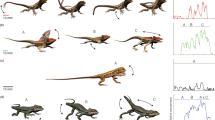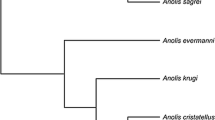Abstract
Signaling species occurring in sympatry are often exposed to similar environmental constraints, so similar adaptations to enhance signal efficacy are expected. However, potentially opposing selective pressures might be present to ensure species recognition. Here, we analyzed the movement-based signals of two pairs of sympatric lizard species to consider how reliable communication is maintained while avoiding misidentification. Our novel approach allows us to quantify signal contrast with plant motion noise at any site we measure, including those utilized by other species. Ctenophorus caudicinctus and Gowidon longirostris differed in display complexity and motor pattern use. They also differed in overall morphology, but their signal contrast scores are strikingly similar. These results demonstrate similar adaptations to their shared environment while maintaining species recognition cues. In contrast, Ctenophorus fordi and Ctenophorus pictus are much closer in appearance, but C. pictus produces considerably higher signal contrast scores, which we suggest is attributable to the absence of territoriality in C. fordi. Taken together, our data provide evidence for adaptation to the local environment in movement-based signals, while also meeting species recognition requirements, but the selective pressure to deal with local conditions is mediated by signal function.







Similar content being viewed by others
References
Alatalo RV, Gustafsson L, Lundberg A (1994) Male coloration and species recognition in sympatric flycatchers. Proc R Soc Lond B Biol Sci 256(1346):113–118. doi:10.1098/rspb.1994.0057
Barth FG, Schmitt A (1991) Species recognition and species isolation in wandering spiders (Cupiennius spp.; Ctenidae). Behav Ecol Sociobiol 29(5):333–339. doi:10.1007/bf00165957
Batschelet E (1981) Circular statistics in biology. Academic Press, New York
Beuttell K, Losos JB (1999) Ecological morphology of caribbean anoles. Herpetol Monogr 13:1–28. doi:10.2307/1467059
Butler MA, Schoener TW, Losos JB (2000) The relationship between sexual size dimorphism and habitat use in Greater Antillean Anolis lizards. Evolution 54(1):259–272. doi:10.1111/j.0014-3820.2000.tb00026.x
Carpenter CC, Ferguson GW (1977) Variation and evolution of stereotyped behavior in reptiles. In: Gans C, Tinkle DW (eds) Biology of the reptilia: ecology and behavior, vol 7A. Academic Press, New York, pp 35–354
Cogger HG (1978) Reproductive cycles, fat body cycles and socio-sexual behaviour in the Mallee Dragon, Amphibolurus fordi (Lacertilia: Agamidae. Aust J Zool 26:653–672
Couldridge VCK, Alexander GJ (2002) Color patterns and species recognition in four closely related species of Lake Malawi cichlid. Behav Ecol 13(1):59–64. doi:10.1093/beheco/13.1.59
Endler JA (1992) Signals, signal conditions, and the direction of evolution. Am Nat 139:S125–S153
Fleishman LJ (1986) Motion detection in the presence and absence of background motion in an Anolis lizard. J Comp Physiol A 159:711–720
Fleishman LJ, Bowman M, Saunders D, Miller WE, Rury MJ, Loew ER (1997) The visual ecology of Puerto Rican anoline lizards: habitat light and spectral sensitivity. J Comp Physiol A 181:446–460
Garcea R, Gorman G (1968) A difference in male territorial display behavior in two sibling species of Anolis. Copeia 2:419–420
Gibbons JRH (1979) The hind leg pushup display of the Amphibolurus decresii species complex (Lacertilia: Agamidae). Copeia 1979(1):29–40
Harmon LJ, Kolbe JJ, Cheverud JM, Losos JB (2005) Convergence and the multidimensional niche. Evolution 59(2):409–421
Hedrick TL (2008) Software techniques for two- and three-dimensional kinematic measurements of biological and biomimetic systems. Bioinspir Biomim 3:1–6
Hennig RM, Weber T (1997) Filtering of temporal parameters of the calling song by cricket females of two closely related species: a behavioral analysis. J Comp Physiol A 180(6):621–630. doi:10.1007/s003590050078
Hunter ML, Krebs JR (1979) Geographical variation in the song of the Great Tit (Parus major) in relation to ecological factors. J Anim Ecol 48(3):759–785
Jenssen TA (1971) Display analysis of Anolis nebulosus (Sauria, Iguanidae). Copeia 1971(2):197–209. doi:10.2307/1442819
Jenssen TA (1977) Evolution of anoline lizard display behavior. Am Zool 17(1):203–215
Jenssen TA, Gladson NL (1984) A comparative display analysis of the Anolis brevirostris complex in Haiti. J Herpetol 18(3):217–230. doi:10.2307/1564075
Jenssen TA, Orrell KS, Lovern MB (2000) Sexual dimorphisms in aggressive signal structure and use by a polygynous lizard, Anolis carolinensis. Copeia 1:140–149
Leal M, Fleishman LJ (2002) Evidence for habitat partitioning based on adaptation to environmental light in a pair of sympatric lizard species. Proc R Soc Lond B Biol Sci 269:351–359
Losos JB (1985) An experimental demonstration of the species-recognition role of Anolis dewlap color. Copeia 1985(4):905–910. doi:10.2307/1445240
Macarthur RH (1965) Patterns of species diversity. Biol Rev 40(4):510–533. doi:10.1111/j.1469-185X.1965.tb00815.x
Macedonia JM (2001) Habitat light, colour variation, and ultraviolet reflectance in the Grand Cayman anole, Anolis conspersus. Biol J Linn Soc 73(3):299–320. doi:10.1111/j.1095-8312.2001.tb01365.x
Macedonia JM, Stamps JA (1994) Species recognition in Anolis grahami (Sauria, Iguanidae): evidence from responses to video playbacks of conspecific and heterospecific displays. Ethology 98(3–4):246–264. doi:10.1111/j.1439-0310.1994.tb01074.x
Martins EP (1993) A comparative study of the evolution of Sceloporus push-up displays. Am Nat 142(6):994–1018
Martins ElP, Labra A, Halloy M, Thompson JT (2004) Large-scale patterns of signal evolution: an interspecific study of Liolaemus lizard headbob displays. Anim Behav 68(3):453–463. doi:10.1016/j.anbehav.2003.08.026
McLean CA, Moussalli A, Stuart-Fox D (2014) Local adaptation and divergence in colour signal conspicuousness between monomorphic and polymorphic lineages in a lizard. J Evol Biol 27:2654–2664
Morton ES (1975) Ecological sources of selection on avian sounds. Am Nat 109(965):17–34
New STD (2014) Eye of the dragon. Visual specializations of the Jacky dragon, Amphibolurus muricatus. The Australian National University
Nicholson KE, Harmon LJ, Losos JB (2007) Evolution of Anolis lizard dewlap diversity. PLoS One 3:1–12
Ord TJ, Martins EP (2006) Tracing the origins of signal diversity in anole lizards: phylogenetic approaches to inferring the evolution of complex behaviour. Anim Behav 71:1411–1429
Peters RA, Clifford CWG, Evans CS (2002) Measuring the structure of dynamic visual signals. Anim Behav 64:131–146
Peters RA, Hemmi JM, Zeil J (2007) Signaling against the wind: modifying motion-signal structure in response to increase noise. Curr Biol 17:1231–1234
Peters RA, Hemmi J, Zeil J (2008) Image motion environments: background noise for movement-based animal signals. J Comp Physiol A 194:441–456
Peters RA, Ramos JA, Hernandez J, Wu Y, Qi Y (2016) Social context affects tail displays by Phrynocephalus vlangalii lizards from China. Sci Rep 6:31573. doi:10.1038/srep31573
Pianka ER (1967) On lizard species diversity: North American flatland deserts. Ecology 48(3):333–351. doi:10.2307/1932670
Ramos JA, Peters RA (2016) Dragon wars: movement-based signalling by Australian agamid lizards in relation to species ecology. Aust Ecol 41(3):302–315
Ramos JA, Peters RA (2017a) Quantifying ecological constraints on motion signaling. Front Ecol Evol. doi:10.3389/fevo.2017.00009
Ramos JA, Peters RA (2017b) Habitat-dependent variation in motion signal structure between allopatric populations of lizards. Anim Behav 126:69–78. doi:10.1016/j.anbehav.2017.01.022
Rand AS, Williams EE (1970) An estimation of redundancy and information content of anole dewlaps. Am Nat 104(935):99–103
Rousseeuw PJ, Croux C (1993) Alternatives to the median absolute deviation. J Am Stat Assoc 88(424):1273–1283
Seddon N (2005) Ecological adaptation and species recognition drives vocal evolution in neotropical suboscine birds. Evolution 59(1):200–215. doi:10.1111/j.0014-3820.2005.tb00906.x
Simpson GG (1964) Species density of North American recent mammals. Syst Zool 13(2):57–73. doi:10.2307/2411825
Slabbekoorn H, Boer-Visser Ad (2006) Cities change the songs of birds. Curr Biol 16(23):2326–2331
Slabbekoorn H, Smith TB (2002) Habitat-dependent song divergence in the little greenbul: an analysis of environmental selection pressures on acoustic signals. Evolution 56(9):1849–1858. doi:10.1111/j.0014-3820.2002.tb00199.x
Steinberg DS, Leal M (2013) Sensory system properties predict signal modulation in a tropical lizard. Anim Behav 85:623–629
Steinberg DS, Leal M (2016) Visual motion detection and habitat preference in Anolis lizards. J Comp Physiol A 202:783–790
Stuart-Fox DM, Moussalli A, Johnston GR, Owens IPF (2004) Evolution of color variation in dragon lizards: quantitative tests of the role of crypsis and local adaptation. Evolution 58(7):1549–1559. doi:10.1111/j.0014-3820.2004.tb01735.x
Tubaro PL, Segura ET (1995) Geographic, ecological and subspecific variation in the song of the rufous-browed peppershrike (Cyclarhis gujanensis). Condor 97(3):792–803. doi:10.2307/1369187
Vanhooydonck B, Herrel A, Meyers JJ, Irschick DJ (2009) What determines dewlap diversity in Anolis lizards? An among-island comparison. J Evol Biol 22(2):293–305. doi:10.1111/j.1420-9101.2008.01643.x
Williams EE, Rand AS (1977) Species recognition, dewlap function and faunal size. Am Zool 17(1):261–270. doi:10.1093/icb/17.1.261
Wilson S, Swan G (2013) A complete guide to reptiles of Australia, 4th edn. New Holland Publishers, Sydney
Acknowledgements
We would like to thank Martin Elizalde, Leanne Scott, Paul Davies, Juan Hernandez, Kate Beskeen, and Matt Sleeth for their invaluable help during the data collection stages of this project.
Author information
Authors and Affiliations
Corresponding author
Ethics declarations
Conflict of interest
The authors declare that they have no conflict of interest.
Electronic supplementary material
Below is the link to the electronic supplementary material.
Supplementary material 1 (MP4 208461 kb)
Rights and permissions
About this article
Cite this article
Ramos, J.A., Peters, R.A. Motion-based signaling in sympatric species of Australian agamid lizards. J Comp Physiol A 203, 661–671 (2017). https://doi.org/10.1007/s00359-017-1185-5
Received:
Revised:
Accepted:
Published:
Issue Date:
DOI: https://doi.org/10.1007/s00359-017-1185-5




